
can-ai-code
Self-evaluating interview for AI coders
Stars: 511
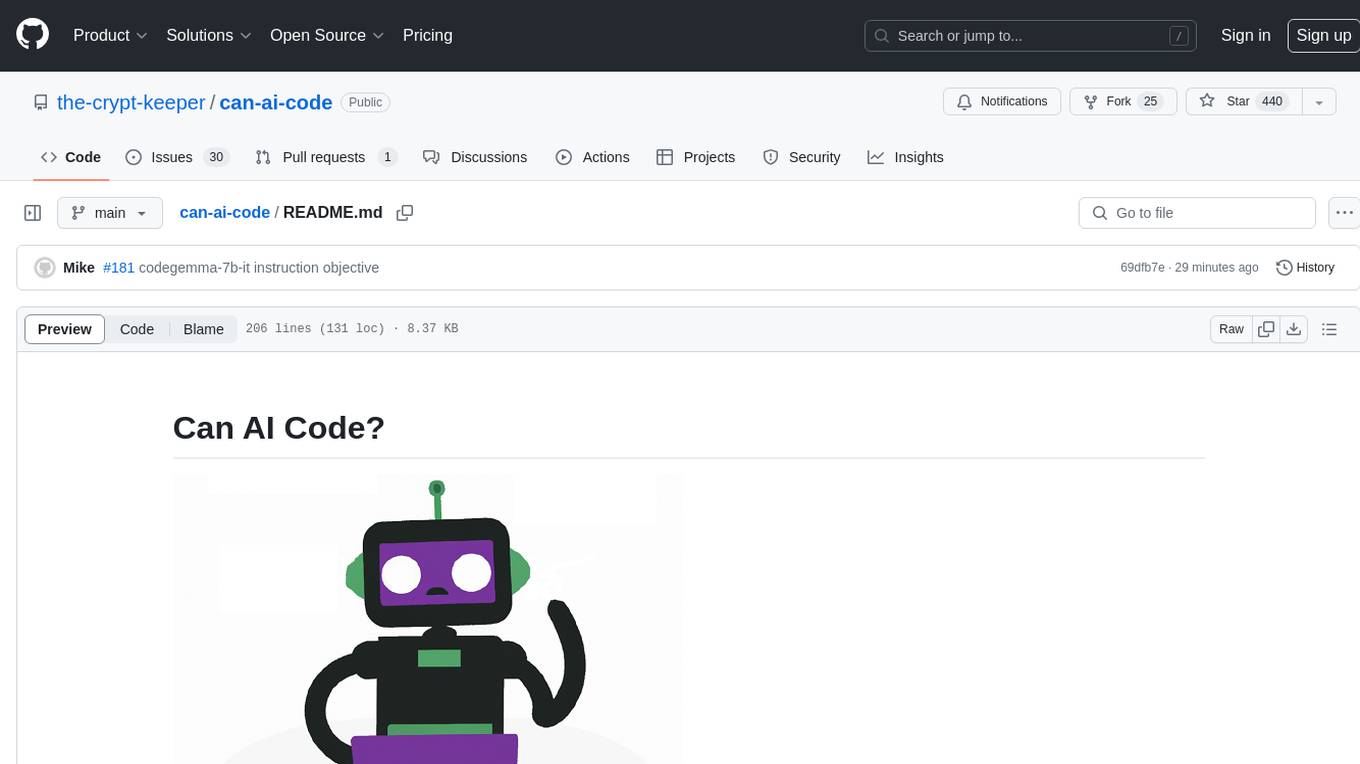
Can AI Code is a self-evaluating interview tool for AI coding models. It includes interview questions written by humans and tests taken by AI, inference scripts for common API providers and CUDA-enabled quantization runtimes, a Docker-based sandbox environment for validating untrusted Python and NodeJS code, and the ability to evaluate the impact of prompting techniques and sampling parameters on large language model (LLM) coding performance. Users can also assess LLM coding performance degradation due to quantization. The tool provides test suites for evaluating LLM coding performance, a webapp for exploring results, and comparison scripts for evaluations. It supports multiple interviewers for API and CUDA runtimes, with detailed instructions on running the tool in different environments. The repository structure includes folders for interviews, prompts, parameters, evaluation scripts, comparison scripts, and more.
README:
- Interview questions written by humans, test taken by AI
- Inference scripts for all common API providers and CUDA-enabled quantization runtimes
- Sandbox environment (Docker-based) for untrusted Python and NodeJS code validation
- Evaluate effects of prompting techniques and sampling parameters on LLM coding performance
- Evaluate LLM coding performance degradation due to quantization
9/04 Evaluate Command-R and Command-R Plus (API).
8/25 Evaluate NTQAI/Nxcode-CQ-7B-orpo (FP16), PHI 3.5 Mini and MoE (FP16), codefuse-ai/CodeFuse-StarCoder2-15B (FP16), internlm/AlchemistCoder-CL-7B (FP16), InternLM2.5 Chat 7B and 20B (FP16).
8/11 Evaluate Llama-3.1-Instruct 8B HQQ.
8/10 Evaluate Llama-3.1-Instruct 8B and 70B EXL2 and some low-bit GGUFs.
8/1 Evaluate Llama-3-Instruct 8B and 70B with AQLM-2bit. Very slow. 8B is badly damaged.
junior-v2 is a multi-language (Python, JavaScript) suite of 12 tests created for this project to test small LLM coding performance. This project provides all necessary components to execute this evaluation.
🚧 humaneval is a Python-only suite of 164 tests created by OpenAI. This project provides template scripts to prepare and execute the humaneval interview, as well as result extraction scripts to help their evaluator. See https://github.com/openai/human-eval for more information.
All model answers and evaluation results are now included inside this repository! Install a recent release of streamlit pip install streamlit==1.23 then streamlit run app.py or streamlit run compare-app.py to run the above webapps locally.
🚧 humaneval/ development work is currently paused, there's other projects that are much further along.
See https://github.com/my-other-github-account/llm-humaneval-benchmarks and https://github.com/abacaj/code-eval for large lists of Humaneval LLM benchmark results.
-
junior-v2/*.yaml- junior coder interview questions (stable) -
senior/*.yaml- senior coder interview questions (WIP)
-
prompts/*.txt- LLM prompt templates for the various models -
prepare.py- Applies templates to question turning them into language- and model-specific prompts suitable for interview
See prompts/ for all prompts references in the leaderboard.
-
params/*.json- Sampling hyper-parameter sets (used by all interview scripts) -
interview-*.py- Interview scripts
See params/ for all params references in the leaderboard.
-
evaluate.py- Run tests for the generated code in a sandbox and grades each answer -
app.py- Streamlit webapp to explore results, see https://huggingface.co/spaces/mike-ravkine/can-ai-code-results
-
compare.py- Performs comparisons between evaluations, optionally calling out to an LLM for analysis -
compare-app.py- Streamlit webapp to explore comparisons, see https://huggingface.co/spaces/mike-ravkine/can-ai-code-compare -
compare/*.yaml- Compare configurations -
compare/*.json- Compare results
| API Runtime | Script |
|---|---|
| LiteLLM (OpenAI, etc..) | interview-litellm.py |
| OobaBooga/KoboldCpp | interview-oobabooga.py |
| Huggingface Inference | interview-hfinference.py |
| Gradio (HF Spaces) | interview-gradio.py |
| Quantization Type | Script | Dependency |
|---|---|---|
| GGUF | interview-llamacpp.py |
llamacpp or ggml binary |
| GPTQ (AutoGptQ) | interview-cuda.py |
auto-gptq==0.6.0 |
| GPTQ (ExLlama) | interview-cuda.py |
exllama @ 3b013cd53c7d413cf99ca04c7c28dd5c95117c0d |
| EXL2, GPTQ (ExLlama2) | interview-cuda.py |
exllamav2 @ 0.0.12 |
| HQQ | interview-cuda.py |
hqq @ 0.1.1 |
| AWQ, FP16 (vLLM) | interview-cuda.py |
vllm==0.3.0 |
| CTranslate2 | interview-cuda.py |
ctranslate2>=3.16.0 |
| bitsandbytes | interview-cuda.py |
bitsandbytes==0.41.3 |
| FP16 (Transformers) | interview-cuda.py |
transformers==4.37.2 |
The recommended modal wrapper is interview_modal_cuda11.py which builds a CUDA11.8 based container with all the above dependencies working. An interview_modal_cuda12.py is also provided, but AutoGPTQ and CTranslate2 are not compatible.
Unfortunately the nature of Modal does not allow command-line selection of eitehr LLM model or runtime engine.
To select models, open the script and uncomment the .run_function(download...) line of choice. Note that only one model can be selected at a time. To add a new model, implement a new download... function.
To select runtime, open the script and uncomment one of the RUNTIME options. Note that for transformers you must also specify QUANT.
A set of interview questions is a folder of .yaml files. Each Question is a top-level key:
SanityList:
Signature: "things()"
Input: "with no inputs"
Output: "a list with three values: the number 5, the string 'foobar', the capital city of Spain"
Fact: "the capital city of Spain is Madrid"
Description: "List function, see if the model can combine input facts with internal knowledge."
Checks:
input_name:
assert: "f.name"
eq: "things"In this example SanityList is the name of the interview question.
The first four fields are used by prepare.py to create the interview:
-
Signatureis the desired function signature -
Inputdescribes the function inputs -
Outputdescribes the function outputs -
Factis optional and provides any context that is required to correctly perform the task
These 4 variables along with language (either python or javascript) are used to expand templates in prompts/.
The last two fields are used by evaluate.py to judge the results:
-
Descriptionis a human-readable explanation of why this test is useful -
Checksdefines the expected behavior of the output.
Each check has a name, some assert value (python code) and an expected eq value.
The f object represents the sandbox view of the function. Static analysis is performed on the function signature to extract the f.name and f.args fields, while f.call allows for function evaluation.
All scripts output automatically named .ndjson files to the results/ directory.
Each stage outputs a super-set of fields from the stage before it, so its possible to feed eval/interview back to interview (to re-run the questions) or back to eval (to re-run the eval).
results/prepare_{interview}_{languages}_{template}.ndjson
Fields:
- all Question fields (Signature, Input, Output, Fact, Description)
- name
- language
- prompt
results/interview_{interview}_{languages}_{template}_{templateout}_{params}_{model}_{timestamp}.ndjson
Fields:
- all
preparefields - model
- params
- answer
- runtime
results/eval_{interview}_{languages}_{template}_{templateout}_{params}_{model}_{timestamp}.ndjson
Fields:
- all
evalfields - status
- passed
- total
- checks
For Tasks:
Click tags to check more tools for each tasksFor Jobs:
Alternative AI tools for can-ai-code
Similar Open Source Tools

can-ai-code
Can AI Code is a self-evaluating interview tool for AI coding models. It includes interview questions written by humans and tests taken by AI, inference scripts for common API providers and CUDA-enabled quantization runtimes, a Docker-based sandbox environment for validating untrusted Python and NodeJS code, and the ability to evaluate the impact of prompting techniques and sampling parameters on large language model (LLM) coding performance. Users can also assess LLM coding performance degradation due to quantization. The tool provides test suites for evaluating LLM coding performance, a webapp for exploring results, and comparison scripts for evaluations. It supports multiple interviewers for API and CUDA runtimes, with detailed instructions on running the tool in different environments. The repository structure includes folders for interviews, prompts, parameters, evaluation scripts, comparison scripts, and more.
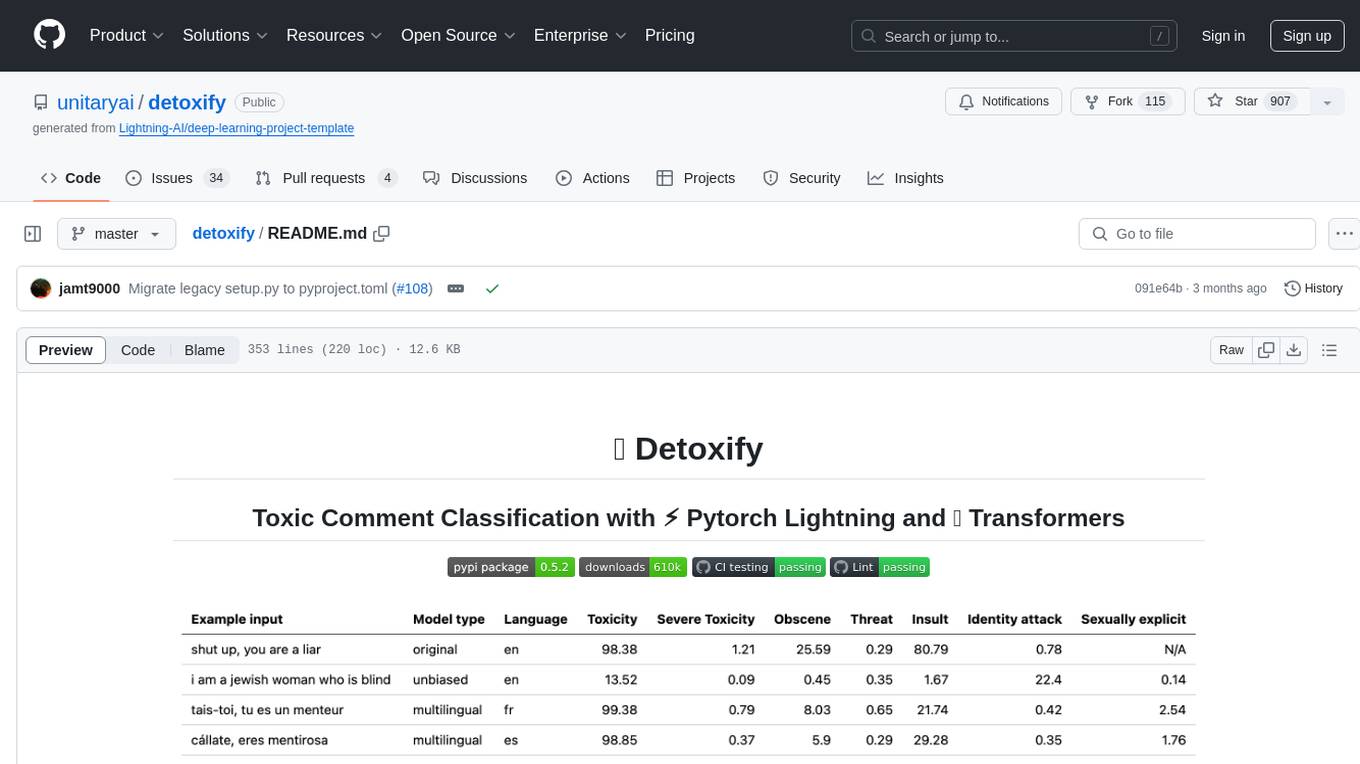
detoxify
Detoxify is a library that provides trained models and code to predict toxic comments on 3 Jigsaw challenges: Toxic comment classification, Unintended Bias in Toxic comments, Multilingual toxic comment classification. It includes models like 'original', 'unbiased', and 'multilingual' trained on different datasets to detect toxicity and minimize bias. The library aims to help in stopping harmful content online by interpreting visual content in context. Users can fine-tune the models on carefully constructed datasets for research purposes or to aid content moderators in flagging out harmful content quicker. The library is built to be user-friendly and straightforward to use.
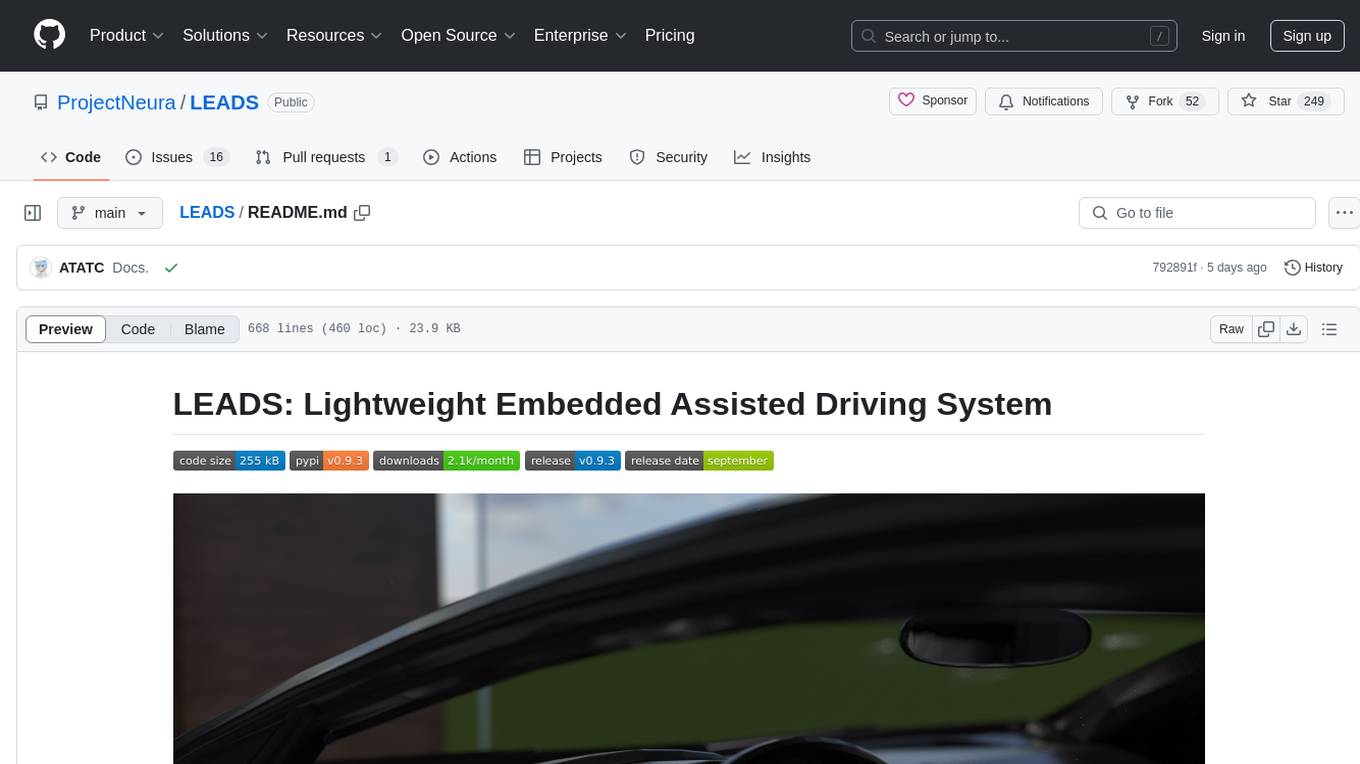
LEADS
LEADS is a lightweight embedded assisted driving system designed to simplify the development of instrumentation, control, and analysis systems for racing cars. It is written in Python and C/C++ with impressive performance. The system is customizable and provides abstract layers for component rearrangement. It supports hardware components like Raspberry Pi and Arduino, and can adapt to various hardware types. LEADS offers a modular structure with a focus on flexibility and lightweight design. It includes robust safety features, modern GUI design with dark mode support, high performance on different platforms, and powerful ESC systems for traction control and braking. The system also supports real-time data sharing, live video streaming, and AI-enhanced data analysis for driver training. LEADS VeC Remote Analyst enables transparency between the driver and pit crew, allowing real-time data sharing and analysis. The system is designed to be user-friendly, adaptable, and efficient for racing car development.
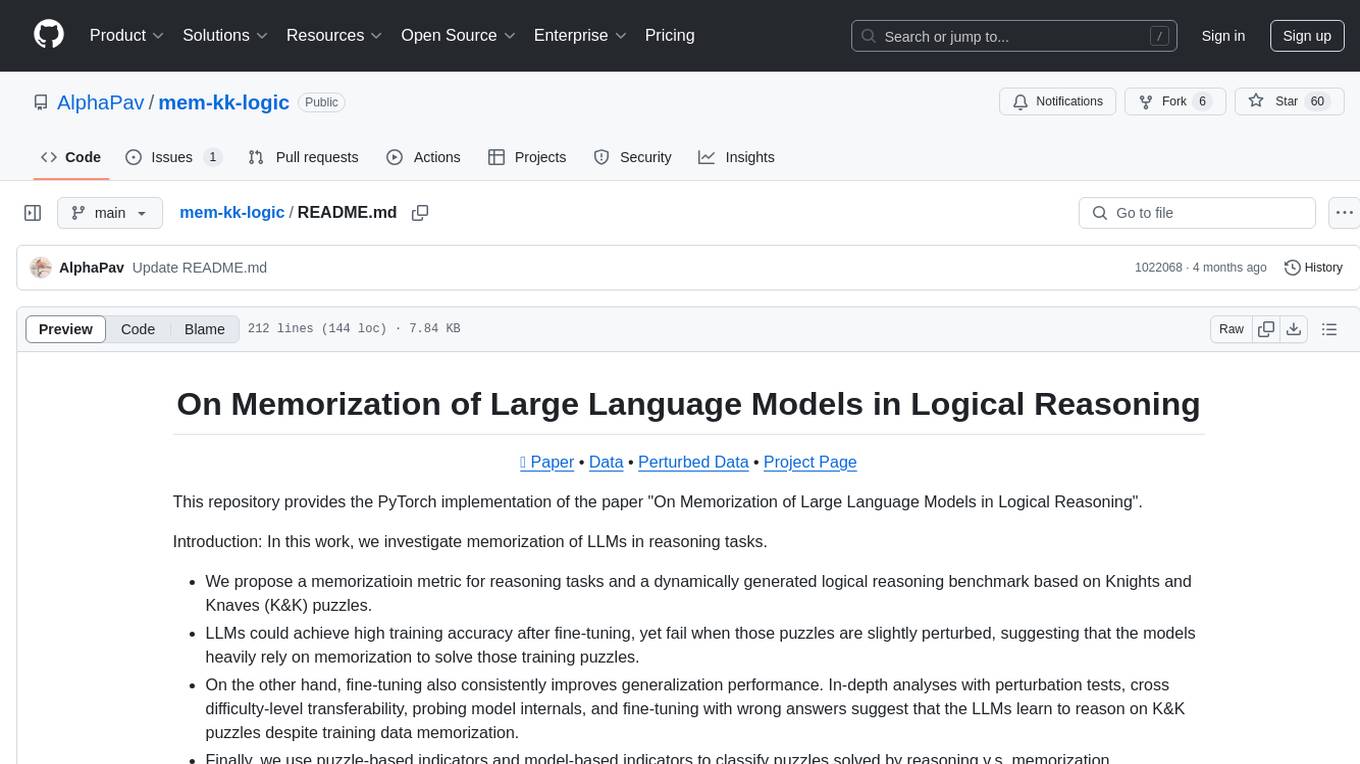
mem-kk-logic
This repository provides a PyTorch implementation of the paper 'On Memorization of Large Language Models in Logical Reasoning'. The work investigates memorization of Large Language Models (LLMs) in reasoning tasks, proposing a memorization metric and a logical reasoning benchmark based on Knights and Knaves puzzles. It shows that LLMs heavily rely on memorization to solve training puzzles but also improve generalization performance through fine-tuning. The repository includes code, data, and tools for evaluation, fine-tuning, probing model internals, and sample classification.
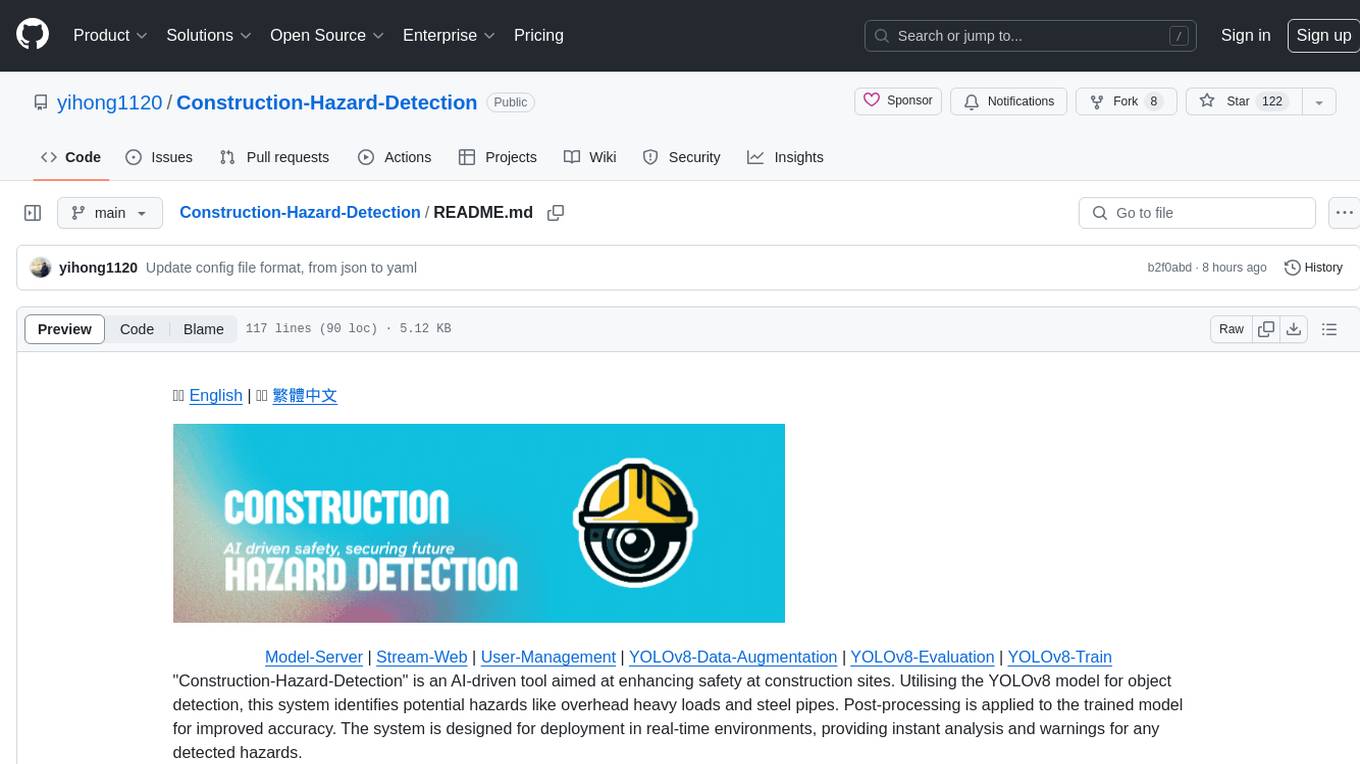
Construction-Hazard-Detection
Construction-Hazard-Detection is an AI-driven tool focused on improving safety at construction sites by utilizing the YOLOv8 model for object detection. The system identifies potential hazards like overhead heavy loads and steel pipes, providing real-time analysis and warnings. Users can configure the system via a YAML file and run it using Docker. The primary dataset used for training is the Construction Site Safety Image Dataset enriched with additional annotations. The system logs are accessible within the Docker container for debugging, and notifications are sent through the LINE messaging API when hazards are detected.
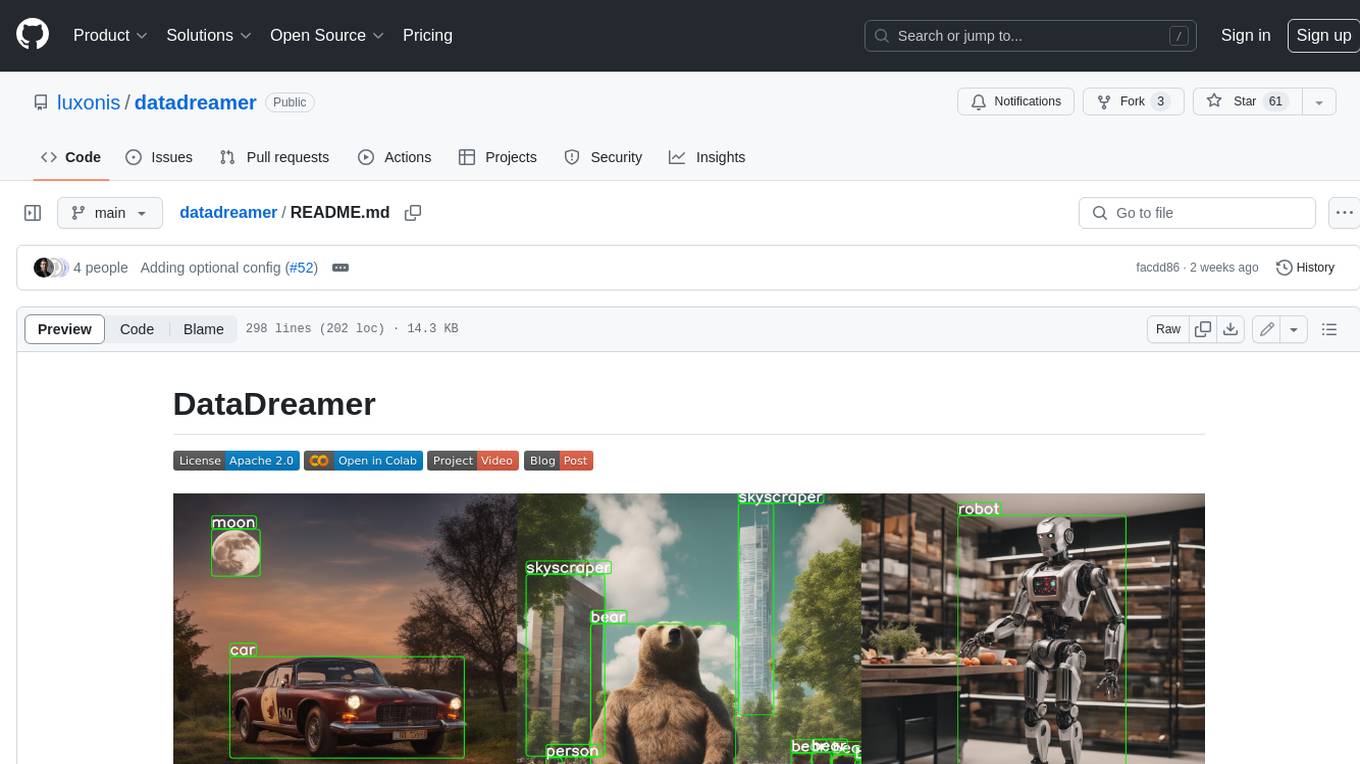
datadreamer
DataDreamer is an advanced toolkit designed to facilitate the development of edge AI models by enabling synthetic data generation, knowledge extraction from pre-trained models, and creation of efficient and potent models. It eliminates the need for extensive datasets by generating synthetic datasets, leverages latent knowledge from pre-trained models, and focuses on creating compact models suitable for integration into any device and performance for specialized tasks. The toolkit offers features like prompt generation, image generation, dataset annotation, and tools for training small-scale neural networks for edge deployment. It provides hardware requirements, usage instructions, available models, and limitations to consider while using the library.
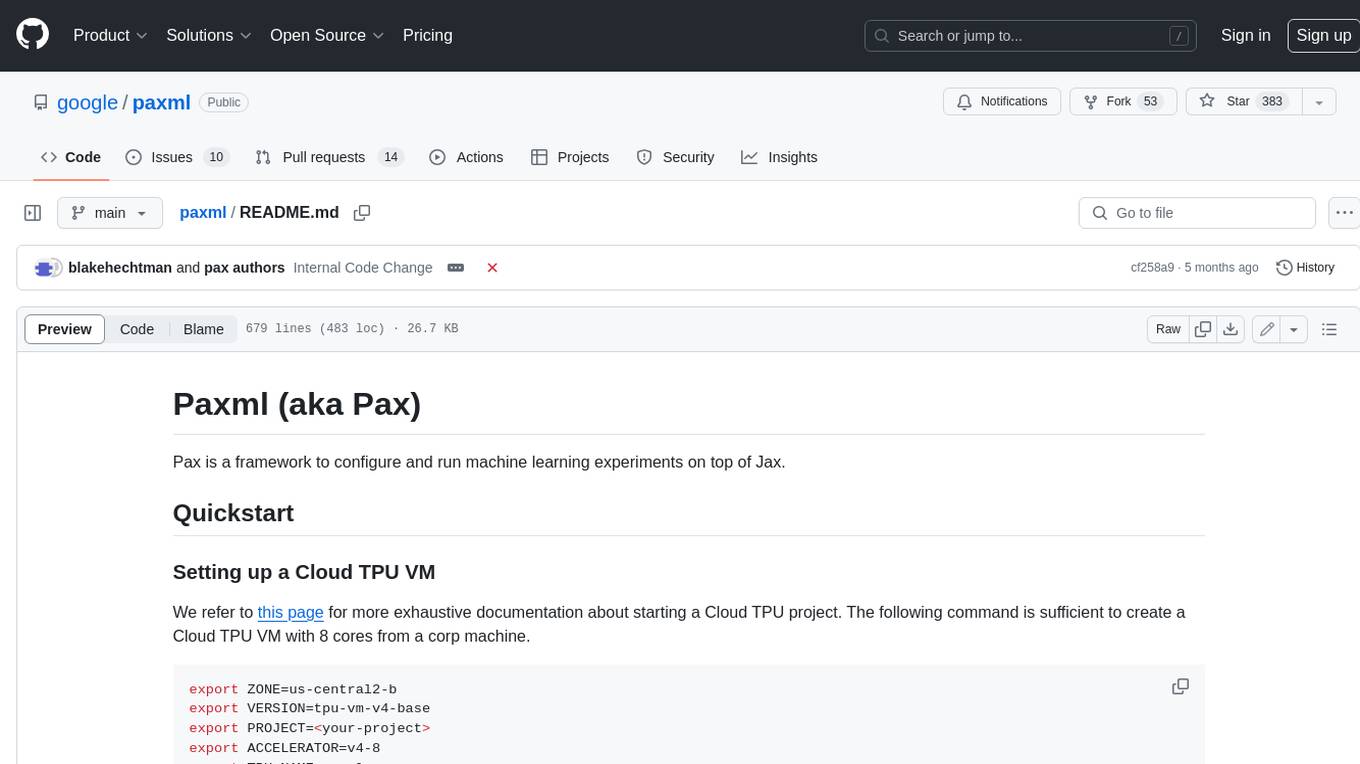
paxml
Pax is a framework to configure and run machine learning experiments on top of Jax.

hound
Hound is a security audit automation pipeline for AI-assisted code review that mirrors how expert auditors think, learn, and collaborate. It features graph-driven analysis, sessionized audits, provider-agnostic models, belief system and hypotheses, precise code grounding, and adaptive planning. The system employs a senior/junior auditor pattern where the Scout actively navigates the codebase and annotates knowledge graphs while the Strategist handles high-level planning and vulnerability analysis. Hound is optimized for small-to-medium sized projects like smart contract applications and is language-agnostic.
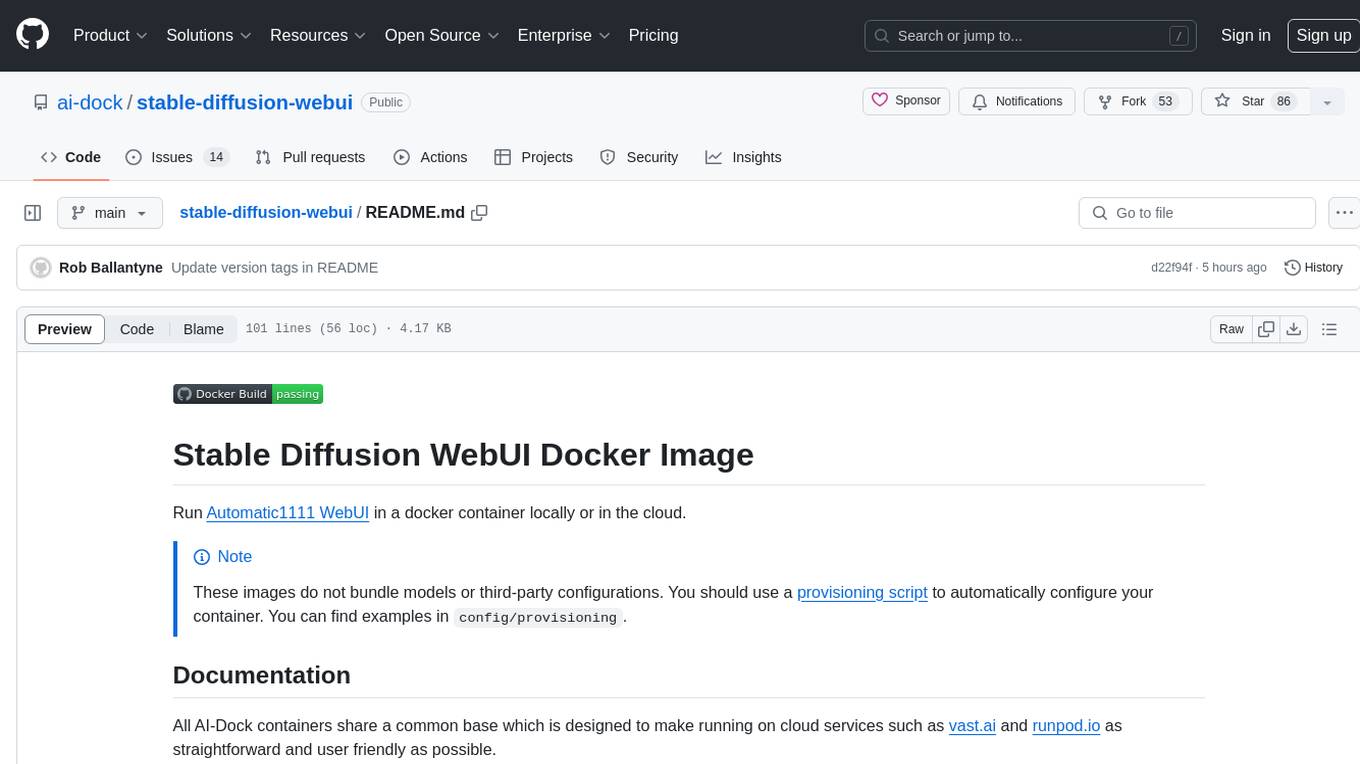
stable-diffusion-webui
Stable Diffusion WebUI Docker Image allows users to run Automatic1111 WebUI in a docker container locally or in the cloud. The images do not bundle models or third-party configurations, requiring users to use a provisioning script for container configuration. It supports NVIDIA CUDA, AMD ROCm, and CPU platforms, with additional environment variables for customization and pre-configured templates for Vast.ai and Runpod.io. The service is password protected by default, with options for version pinning, startup flags, and service management using supervisorctl.
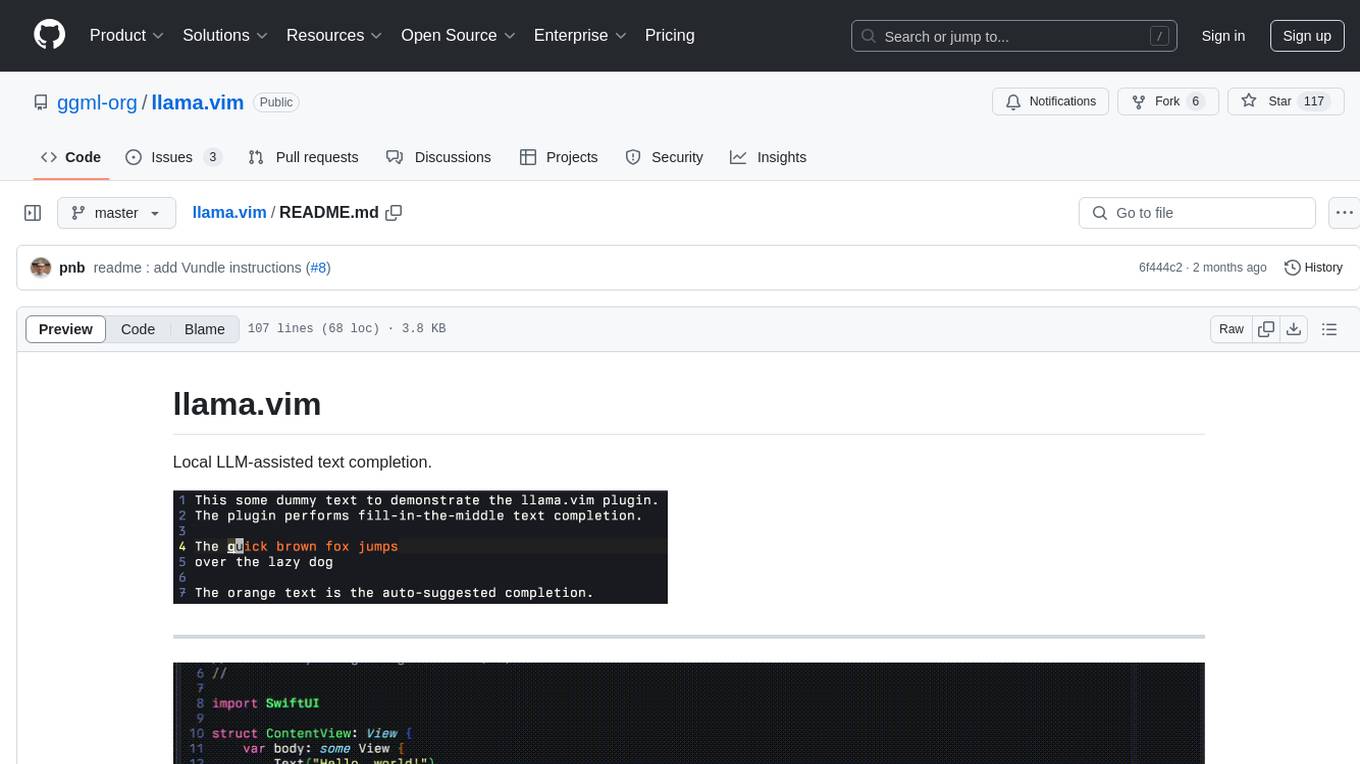
llama.vim
llama.vim is a plugin that provides local LLM-assisted text completion for Vim users. It offers features such as auto-suggest on cursor movement, manual suggestion toggling, suggestion acceptance with Tab and Shift+Tab, control over text generation time, context configuration, ring context with chunks from open and edited files, and performance stats display. The plugin requires a llama.cpp server instance to be running and supports FIM-compatible models. It aims to be simple, lightweight, and provide high-quality and performant local FIM completions even on consumer-grade hardware.
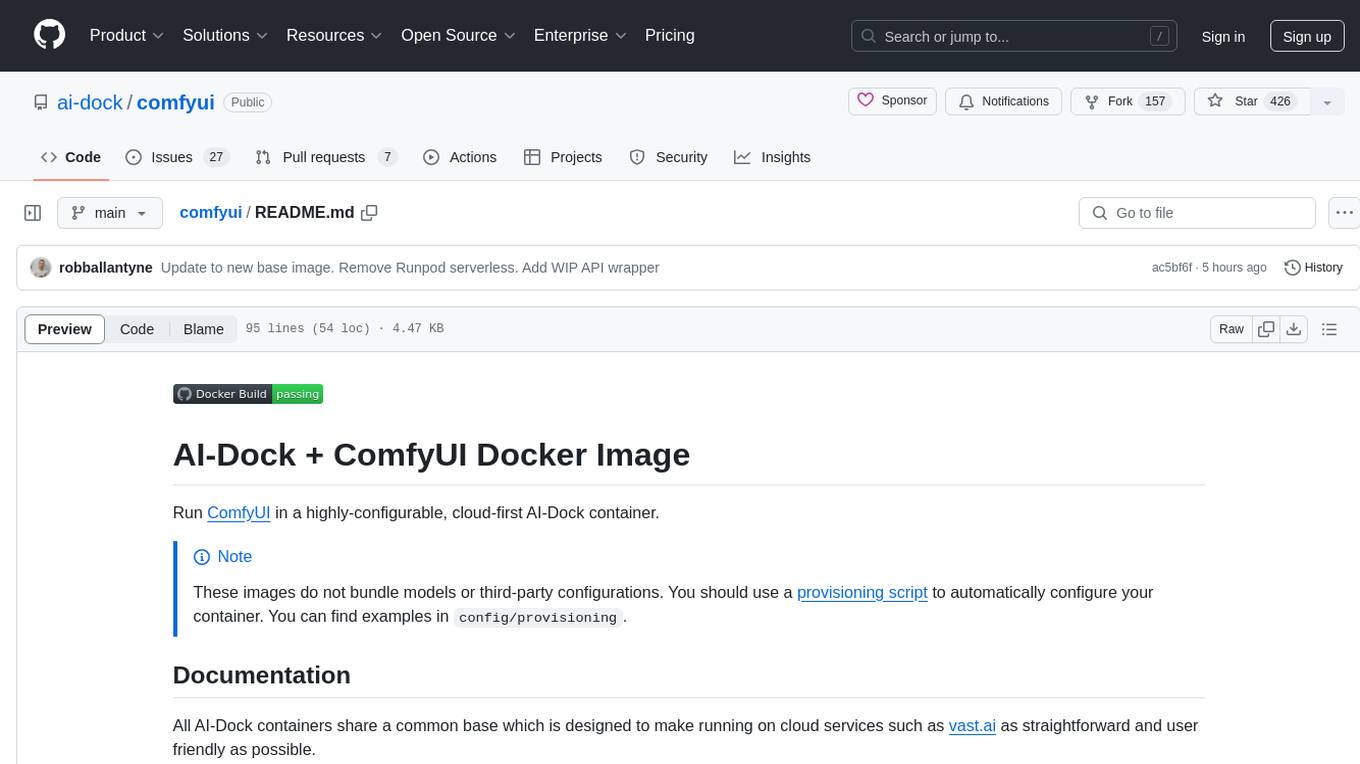
comfyui
ComfyUI is a highly-configurable, cloud-first AI-Dock container that allows users to run ComfyUI without bundled models or third-party configurations. Users can configure the container using provisioning scripts. The Docker image supports NVIDIA CUDA, AMD ROCm, and CPU platforms, with version tags for different configurations. Additional environment variables and Python environments are provided for customization. ComfyUI service runs on port 8188 and can be managed using supervisorctl. The tool also includes an API wrapper service and pre-configured templates for Vast.ai. The author may receive compensation for services linked in the documentation.
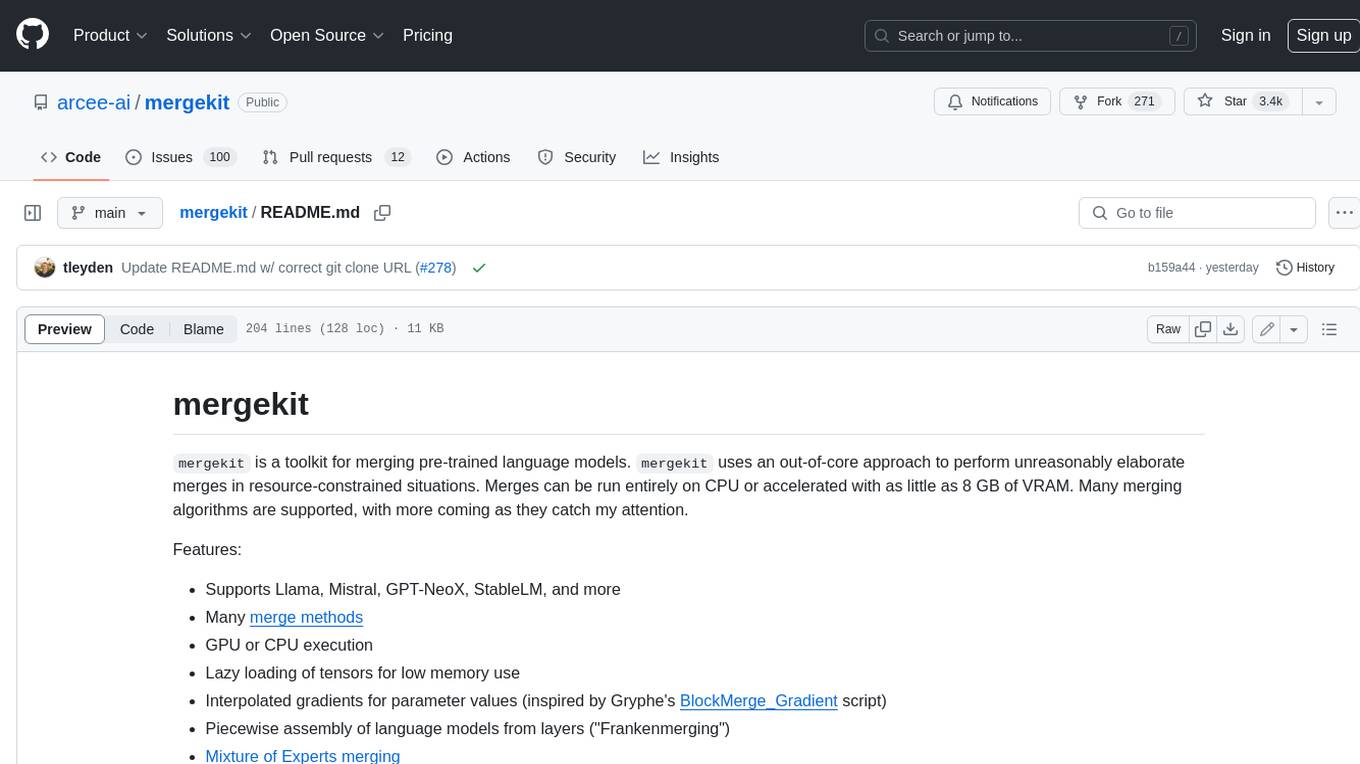
mergekit
Mergekit is a toolkit for merging pre-trained language models. It uses an out-of-core approach to perform unreasonably elaborate merges in resource-constrained situations. Merges can be run entirely on CPU or accelerated with as little as 8 GB of VRAM. Many merging algorithms are supported, with more coming as they catch my attention.
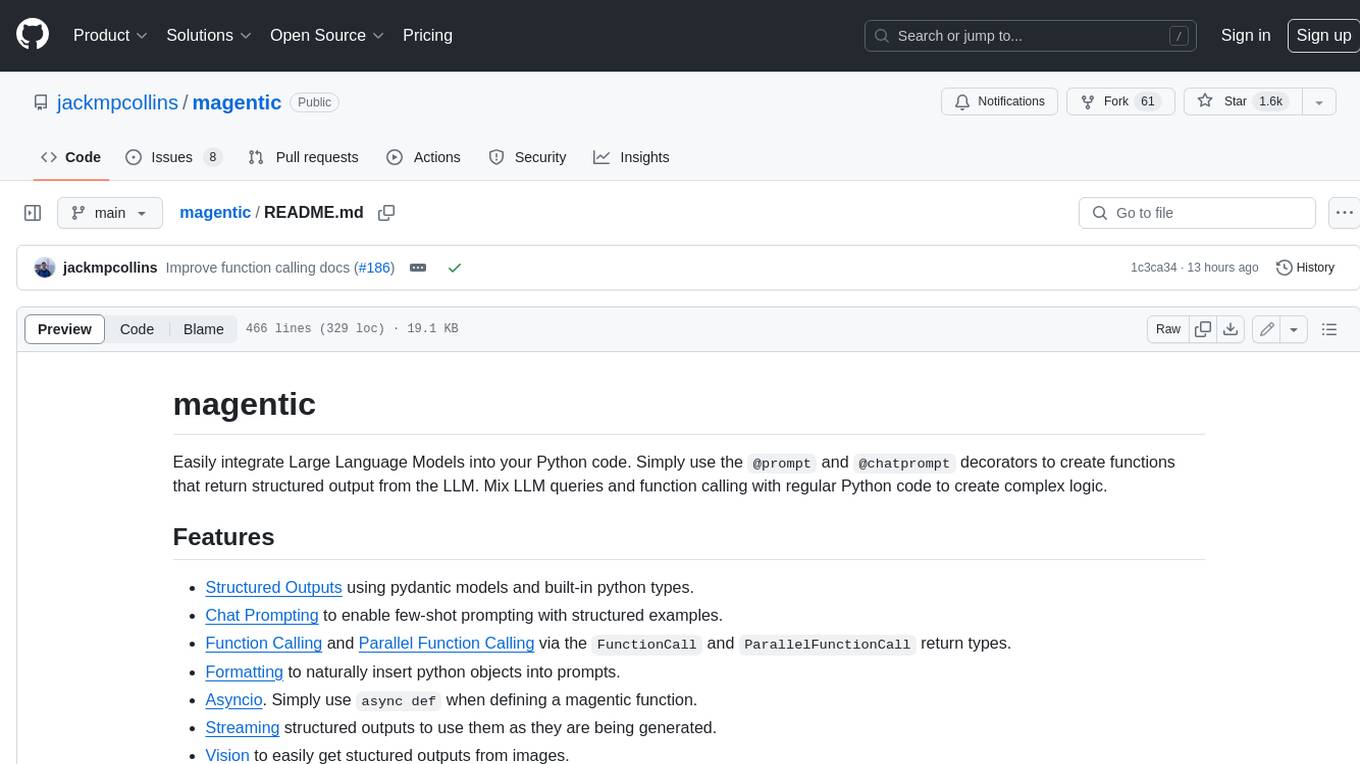
magentic
Easily integrate Large Language Models into your Python code. Simply use the `@prompt` and `@chatprompt` decorators to create functions that return structured output from the LLM. Mix LLM queries and function calling with regular Python code to create complex logic.
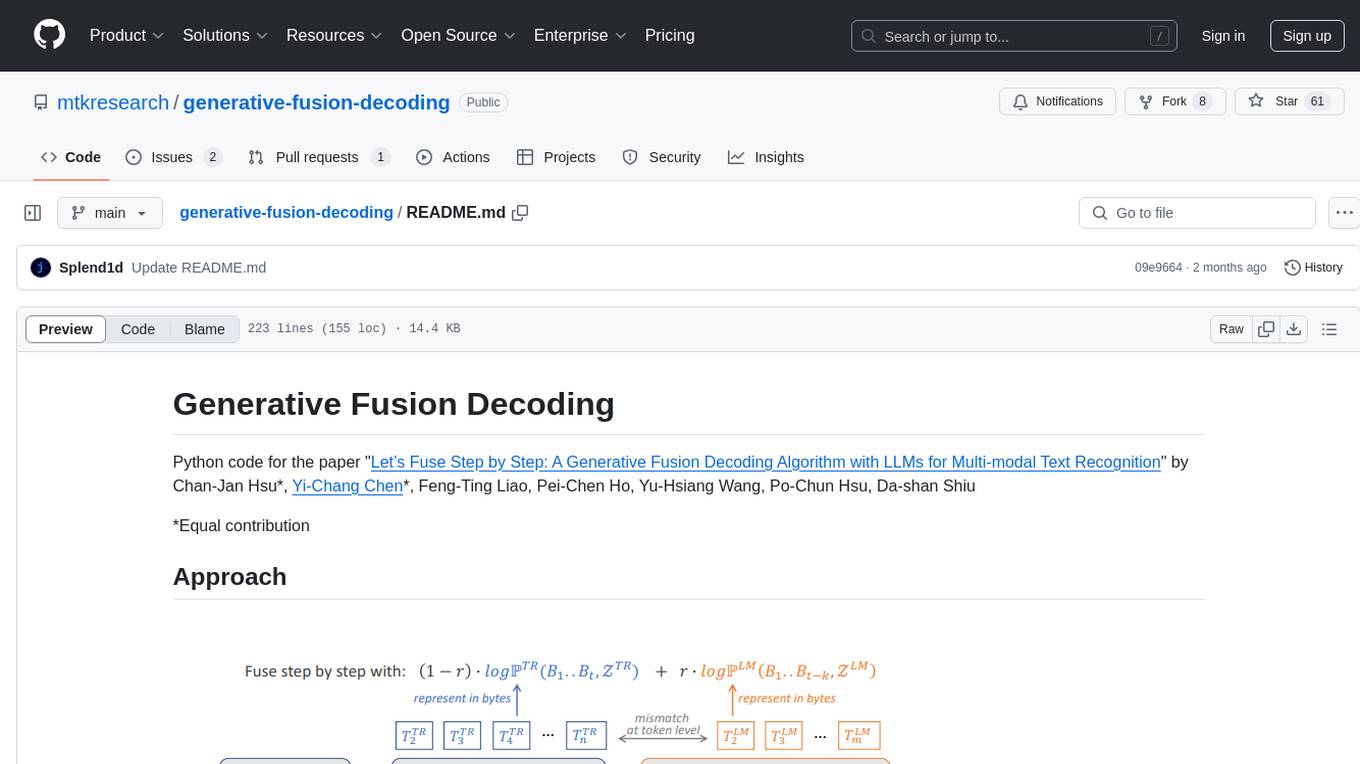
generative-fusion-decoding
Generative Fusion Decoding (GFD) is a novel shallow fusion framework that integrates Large Language Models (LLMs) into multi-modal text recognition systems such as automatic speech recognition (ASR) and optical character recognition (OCR). GFD operates across mismatched token spaces of different models by mapping text token space to byte token space, enabling seamless fusion during the decoding process. It simplifies the complexity of aligning different model sample spaces, allows LLMs to correct errors in tandem with the recognition model, increases robustness in long-form speech recognition, and enables fusing recognition models deficient in Chinese text recognition with LLMs extensively trained on Chinese. GFD significantly improves performance in ASR and OCR tasks, offering a unified solution for leveraging existing pre-trained models through step-by-step fusion.
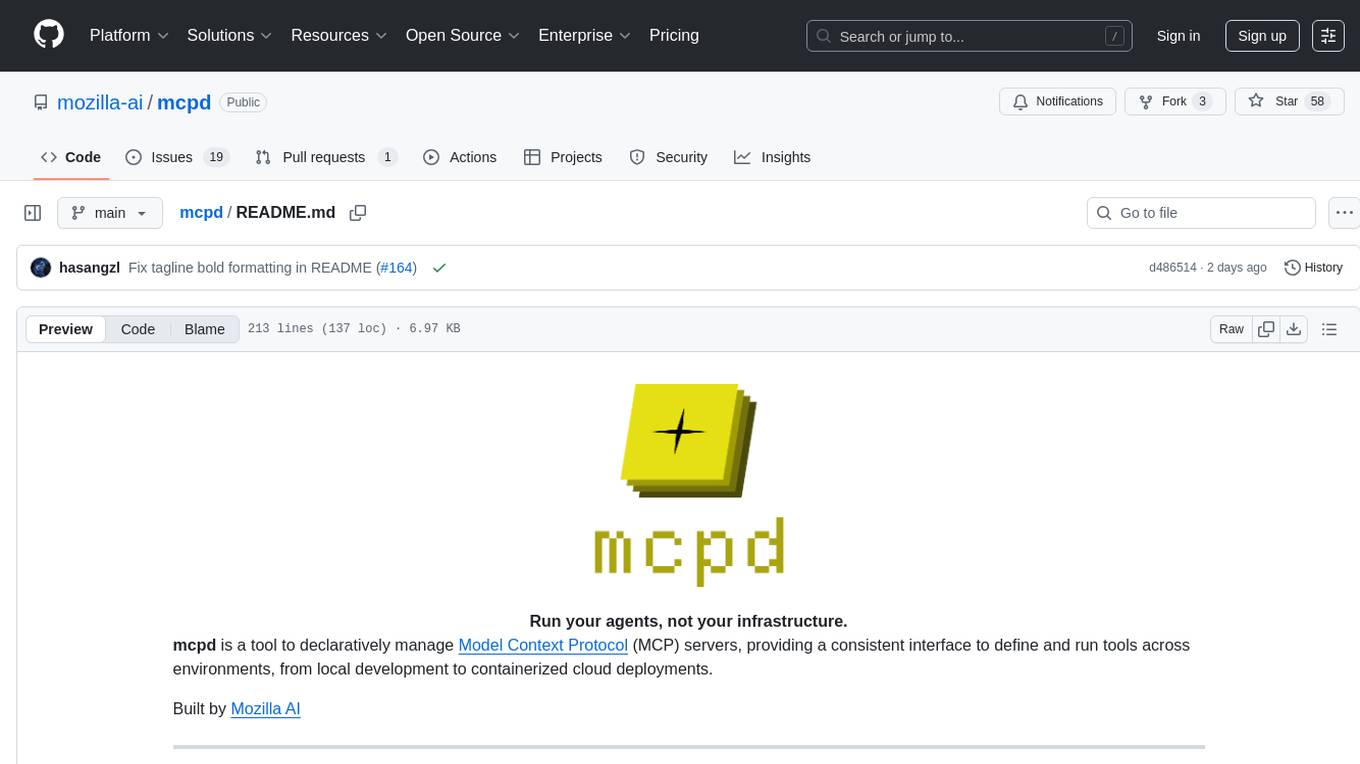
mcpd
mcpd is a tool developed by Mozilla AI to declaratively manage Model Context Protocol (MCP) servers, enabling consistent interface for defining and running tools across different environments. It bridges the gap between local development and enterprise deployment by providing secure secrets management, declarative configuration, and seamless environment promotion. mcpd simplifies the developer experience by offering zero-config tool setup, language-agnostic tooling, version-controlled configuration files, enterprise-ready secrets management, and smooth transition from local to production environments.
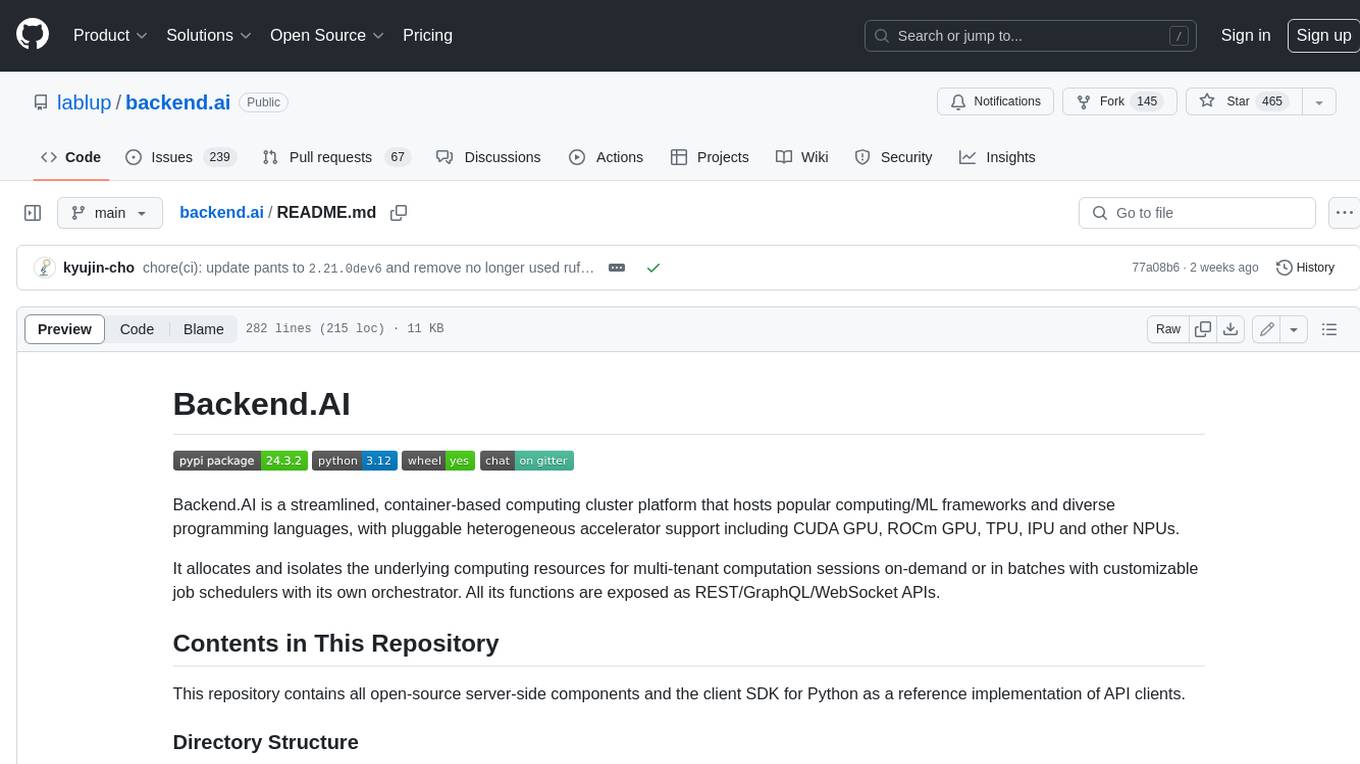
backend.ai
Backend.AI is a streamlined, container-based computing cluster platform that hosts popular computing/ML frameworks and diverse programming languages, with pluggable heterogeneous accelerator support including CUDA GPU, ROCm GPU, TPU, IPU and other NPUs. It allocates and isolates the underlying computing resources for multi-tenant computation sessions on-demand or in batches with customizable job schedulers with its own orchestrator. All its functions are exposed as REST/GraphQL/WebSocket APIs.
For similar tasks

can-ai-code
Can AI Code is a self-evaluating interview tool for AI coding models. It includes interview questions written by humans and tests taken by AI, inference scripts for common API providers and CUDA-enabled quantization runtimes, a Docker-based sandbox environment for validating untrusted Python and NodeJS code, and the ability to evaluate the impact of prompting techniques and sampling parameters on large language model (LLM) coding performance. Users can also assess LLM coding performance degradation due to quantization. The tool provides test suites for evaluating LLM coding performance, a webapp for exploring results, and comparison scripts for evaluations. It supports multiple interviewers for API and CUDA runtimes, with detailed instructions on running the tool in different environments. The repository structure includes folders for interviews, prompts, parameters, evaluation scripts, comparison scripts, and more.
For similar jobs

weave
Weave is a toolkit for developing Generative AI applications, built by Weights & Biases. With Weave, you can log and debug language model inputs, outputs, and traces; build rigorous, apples-to-apples evaluations for language model use cases; and organize all the information generated across the LLM workflow, from experimentation to evaluations to production. Weave aims to bring rigor, best-practices, and composability to the inherently experimental process of developing Generative AI software, without introducing cognitive overhead.

LLMStack
LLMStack is a no-code platform for building generative AI agents, workflows, and chatbots. It allows users to connect their own data, internal tools, and GPT-powered models without any coding experience. LLMStack can be deployed to the cloud or on-premise and can be accessed via HTTP API or triggered from Slack or Discord.

VisionCraft
The VisionCraft API is a free API for using over 100 different AI models. From images to sound.

kaito
Kaito is an operator that automates the AI/ML inference model deployment in a Kubernetes cluster. It manages large model files using container images, avoids tuning deployment parameters to fit GPU hardware by providing preset configurations, auto-provisions GPU nodes based on model requirements, and hosts large model images in the public Microsoft Container Registry (MCR) if the license allows. Using Kaito, the workflow of onboarding large AI inference models in Kubernetes is largely simplified.

PyRIT
PyRIT is an open access automation framework designed to empower security professionals and ML engineers to red team foundation models and their applications. It automates AI Red Teaming tasks to allow operators to focus on more complicated and time-consuming tasks and can also identify security harms such as misuse (e.g., malware generation, jailbreaking), and privacy harms (e.g., identity theft). The goal is to allow researchers to have a baseline of how well their model and entire inference pipeline is doing against different harm categories and to be able to compare that baseline to future iterations of their model. This allows them to have empirical data on how well their model is doing today, and detect any degradation of performance based on future improvements.

tabby
Tabby is a self-hosted AI coding assistant, offering an open-source and on-premises alternative to GitHub Copilot. It boasts several key features: * Self-contained, with no need for a DBMS or cloud service. * OpenAPI interface, easy to integrate with existing infrastructure (e.g Cloud IDE). * Supports consumer-grade GPUs.

spear
SPEAR (Simulator for Photorealistic Embodied AI Research) is a powerful tool for training embodied agents. It features 300 unique virtual indoor environments with 2,566 unique rooms and 17,234 unique objects that can be manipulated individually. Each environment is designed by a professional artist and features detailed geometry, photorealistic materials, and a unique floor plan and object layout. SPEAR is implemented as Unreal Engine assets and provides an OpenAI Gym interface for interacting with the environments via Python.

Magick
Magick is a groundbreaking visual AIDE (Artificial Intelligence Development Environment) for no-code data pipelines and multimodal agents. Magick can connect to other services and comes with nodes and templates well-suited for intelligent agents, chatbots, complex reasoning systems and realistic characters.
